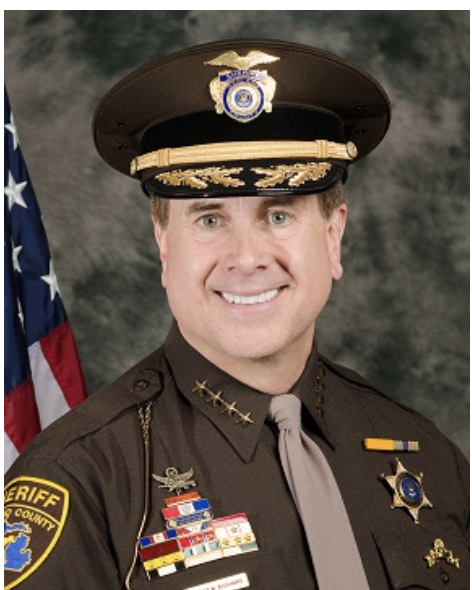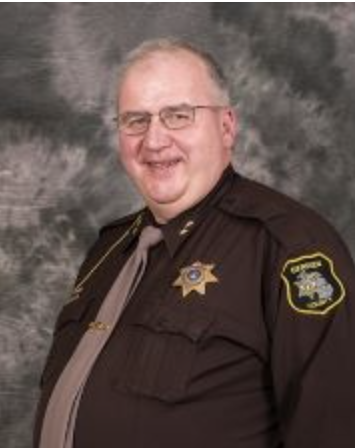
Oakland County
Oakland County Sheriff Michael Bouchard.By LIZ NASS
Capital News Service
LANSING— The Oakland County Sheriff’s Department, which saves one life from opioid overdoses every day, is adopting a new anti-overdose drug while other Michigan law enforcement agencies are waiting to see how effective the drug is.
Sheriff Michael Bouchard announced that his department would be the first agency to use the new nasal spray called Opvee to reverse the effects of fentanyl.
In May, the Food and Drug Administration approved Opvee for health care and public use.
Opvee’s effects can last for several hours, while the commonly used Narcan stays in a person’s system for only 30-90 minutes.
Narcan is also administered as a nasal spray.
In an interview, Bouchard said the department actively searched for innovations to change how its deputies respond on the scene of synthetic opioid overdoses.
In the past year, 103,000 fatalities were reported across the country from overdoses of synthetic opioids such as illicit fentanyl, according to the Food and Drug Administration. Michigan accounted for 2,993 of those deaths.
“If it’s another chance to save a life, let’s go for it,” Bouchard said. “We’d like to be cutting edge, and we’d like to be on the forefront of innovation.”
Bouchard said Oakland County uses Narcan more often than any other county in Michigan, saving at least one life almost daily.
Narcan sometimes must be administered in multiple doses before being effective on an overdose victim, unlike Opvee.
However, current state funding that is allocated to law enforcement agencies for opioid overdose prevention is focused on Narcan distribution instead of new drugs like Opvee.
Oakland County received 200 doses of Opvee. Indivior, the drug’s Virginia manufacturer, the Michigan Alliance of Coalitions for Healthy Communities and the Oakland Community Health Network paid for the initial $7,500 order.
Matt Saxton, the executive director of the Michigan Sheriffs’ Association, said that having to pay this cost of Opvee instead of it being provided by the state may be a reason that other departments are not using the drug yet.
Saxton also said that the specific needs of law enforcement agencies for community use could change the need for Opvee in the departments.
“Some are seeing higher numbers of fentanyl overdoses,” Saxton said. “But law enforcement are using what they’re provided and, oftentimes, that may require additional doses as opposed to just one dose being administered.”
Bouchard also said that most departments may not know about the new anti-overdose drug due to its fast introduction in the state.
Sheriff Paul Bailey of Berrien County said his department is not yet using Opvee because of the cost, so it relies on the state’s free or reduced price Narcan supply instead.
He said that conversations about using Opvee would begin after the addition of the drug to the state funding program.
“The department doesn’t have any plans for the near future of switching from Narcan but that doesn’t mean that won’t change,” Bailey said. “If it does, of course, we would accept that.”
He said the sheriffs’ association would have preliminary findings of Oakland County’s experience with Opvee within the next six months, and a decision will be made from there whether to distribute it through the state program.
Esha Price, the president of the Detroit chapter of Families Against Narcotics, an advocacy group for treatment and reduction of opioid addictions, said she is grateful that a new drug is available to help address Michigan’s opioid crisis.
Price said that while she is excited to see new drugs available to reduce the number of overdose deaths, she would also love to see more prevention and rehab strategies to keep drug users away from drugs after an overdose
“Many people who suffer with drug use and abuse have been exposed at some point in their lives, relatively young, adolescents even,” Price said. “If we wait until someone is 18 or 19 or a young adult to start talking about the effects of drugs and alcohol abuse, we’re in trouble.”
Price said that while there are negative side effects from anti-overdose drugs, she would rather hear about nausea, vomiting and headache after an overdose than have to prematurely bury drug users.
Price said she would also like to see more of the financial resources that Oakland County has, such as Opvee, available in Wayne County and other urban areas in Metro Detroit.
“I pray that this drug helps to save more lives, just as Narcan has done,” Price said. “I pray that we’re hearing good stories a year from now.”
Natasha Bagdasarian, the state’s chief medical executive in the Department of Health and Human Services, said one of the major aspects in reducing the opioid crisis is finding strategies to prevent and reduce the physical and psychological harm that comes with it.
Bagdasarian used the analogy of a fire extinguisher to discuss anti-overdose agents.
“When we think about fire extinguishers, the expectation is that you don’t have to use your fire extinguisher,” Bagdasarian said. “In fact, we don’t want you to have to use your fire extinguisher.
“But it’s something we would like for you to have in your home,” she said. “Because if there is a fire, it can save lives. And that’s the way we think about naloxone,” the generic term for Narcan.
Bouchard said that staying ahead of trends and finding the most cutting-edge drugs to keep communities safe is important to him and Oakland County.
“We try to constantly see what’s happening, or the evolution of the problem, and how we can better protect our community,” Bouchard said.

Berrien County.
Berrien County Sheriff Paul Bailey